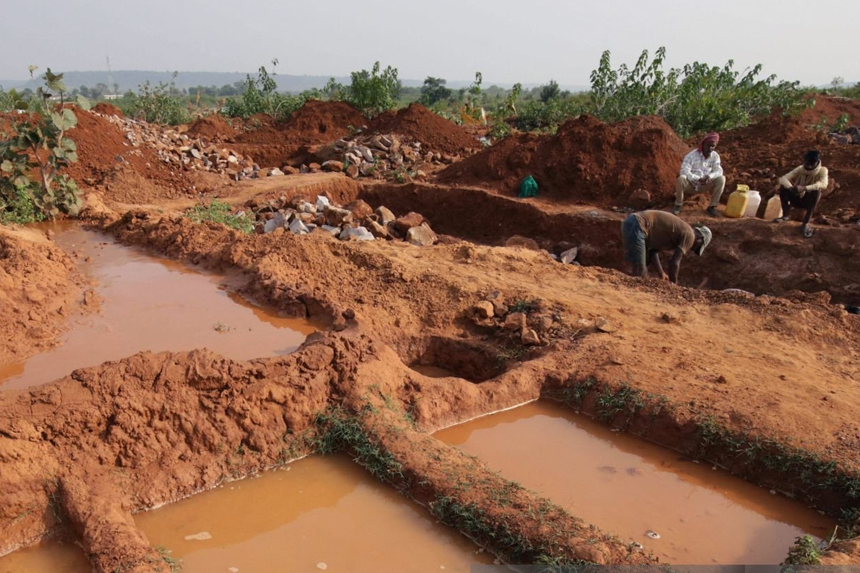What Drives the Diamond Fever?
“Without looking for gems, I feel queasy. Prakash Sharma, an avid diamond hunter from central Madhya Pradesh, India, compares it to a narcotic. At 67, he muses over a life committed to the search for diamonds, a goal that has defined him over the past five decades. He works long hours daily in the Panna district’s diamond mines, a site of promise and suffering for its people.
- What Drives the Diamond Fever?
- How Does Panna Reflect a Region of Contrasts?
- How Do Miners Search for Fortune?
- What Role Does Family Tradition Play in Diamond Hunting?
- Who Are the Lucky Ones in the Search for Diamonds?
- Why Do Some Miners Avoid the Official Route?
- How Do Conservation Efforts Affect Diamond Mining?
- What Does the Future Hold for New Miners?
How Does Panna Reflect a Region of Contrasts?
Panna is among the nation’s most economically deprived areas. Its people struggle with high unemployment rates, water shortages, and poverty. Still, it is also the main target for diamond seekers and hosts most of India’s gemstone reserves. Although the federal government runs many mines, state officials lease small tracts of land to eager miners annually for low rates. The area notably has India’s only automated diamond mine.
But Panna’s once-rich diamond mines are now under construction. Over-mining has greatly diminished their supplies, and many optimistic miners still hunt for the rare jewels among the wreckage of a once-throb sector. “The excitement of the hunt never dies,” says Sharma, who feels an irresistible need to keep looking even if his results drop.
How Do Miners Search for Fortune?
When miners hit gold or diamonds, they had to turn their discoveries on to the government diamond office. After evaluating the stones, the office auctions them. After taxes and royalties are deducted, the profits are returned to the miners, usually leaving them with mixed results for their hard work.
“I wanted to continue doing this instead of getting a low-paying government job,” Sharma says, recounting how he started his diamond-hunting profession straight after finishing school in 1974, following in his father’s footsteps. Early on, he struck the lottery and found a six-carat diamond valued at a fortune fifty years ago. This first achievement stoked his love of diamond hunting.
What Role Does Family Tradition Play in Diamond Hunting?
Among thousands of men, young and old, Mr. Sharma spends his days in the mines working to escape the cycle of poverty. Early each day, miners rummage among gravel for diamonds. Family members typically help with this physically taxing work, and they wash, dry, and sort through their treasures until dusk. For the inhabitants of Panna, diamond hunting is a pillar of hope for a better future and is very rooted in their tradition.
Shyamlal Jatav, 58, comes from a family of diamond hunters; his grandpa initiated the family legacy, and now his son is following suit, juggling his academics while part-time mining. “My grandfather discovered several diamonds, but back then they didn’t sell for much,” Jatav says. ” Now, some of these stones have tens of millions of rupees worth.”
Who Are the Lucky Ones in the Search for Diamonds?
Among the lucky ones is Raja Found, a laborer who had terrible debt until last July, who found a huge 19.22-carat diamond. He sold the gem at a government auction for roughly eight million rupees (approximately $95,178; £72,909). Having rented mining rights for over 10 years, Ground stresses the transforming power of such discoveries: “It’s a dream come true.”
Originally the only diamond source in the world, India has been vital in the worldwide diamond business for about 3,000 years. This was altered in the 18th century with fresh finds in South Africa and Brazil. Still, Panna leaves behind something enduring. With more than 1.3 million carats taken since mining started in 1968, the Majhgawan mine, run by the state-owned National Mineral Development Corporation (NMDC), is still India’s only systematic source of diamond output.
Why Do Some Miners Avoid the Official Route?
Many miners choose to deviate from the approved path even if mining offers chances. Although specific numbers of this trade remain elusive, residents assert that there is a sizable black market for unlawfully mined diamonds. Preferably anonymous, a black-market dealer said, “People sell their finds illegally to avoid taxes and to ensure quick payments.” Should they follow formal processes, they are compensated only following the sale of the diamond at auction, sometimes years away.
Although Panna’s mining officer notes that most diamonds mined are tiny and do not fetch great prices, he admits the difficulties of tracking illicit transactions. The quantity of diamonds offered for government auctions has shockingly dropped under observation by officials. The office received 1,134 diamonds in 2016; that count dropped to just 23 in 2023.
How Do Conservation Efforts Affect Diamond Mining?
A Panna government diamond assessor claims mining limitations have greatly caused this collapse. “The forest department has marked off large areas that diamond hunters would find no-go zones,” he says. The Panna Tiger Reserve boasts over fifty tigers responsible for these constraints. Government initiatives to protect the tiger population have presented further difficulties for miners who used to work in forested environments.
Former workers in these now-protected regions run a great risk of fines should they be discovered. Driven by the hope of bettering their fortunes, many men still labor in the shallow mines despite these challenges.
What Does the Future Hold for New Miners?
One such miner who started his path in 2020 following the COVID-19 lockdown deprived of all work and farming employment in his community is Prakash Majumdar. Desperate and trying to feed his family, Majumdar discovered his first diamond value of 2.9 million rupees in just one month of mining. “It changed everything for us,” he says, pointing out that his family has recently moved into a concrete house, and he has even been chosen as the elected village chief. Declaring, “Diamond hunting will remain a part of my life, and I am not going anywhere until I strike it rich,” he captures the unwavering attitude of Panna’s diamond hunters.








